IN
THE GREAT BELT
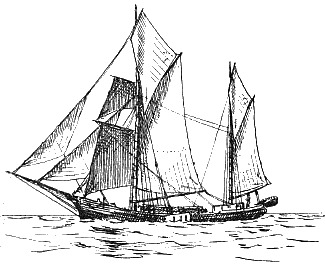 Not
less than the men, the craft of the Baltic form a
never-ending source of interest, and have very well
marked characteristics. With scarcely an exception the
sharp stern is used in all the fishing craft, whether
Finnish, Swedish, Danish, or Norwegian. Sharp floors,
great beam, and considerable rake of stem and stern post,
with wide flare forward, are the rule. The boats are
nearly always clinker-built in wide strakes of great
thickness, and when undecked they usually have high
sheer. The materials used are oak or fir, and wooden
pegging is much resorted to. Not
less than the men, the craft of the Baltic form a
never-ending source of interest, and have very well
marked characteristics. With scarcely an exception the
sharp stern is used in all the fishing craft, whether
Finnish, Swedish, Danish, or Norwegian. Sharp floors,
great beam, and considerable rake of stem and stern post,
with wide flare forward, are the rule. The boats are
nearly always clinker-built in wide strakes of great
thickness, and when undecked they usually have high
sheer. The materials used are oak or fir, and wooden
pegging is much resorted to.
As regards rigging,
pole-masts of very good height are usual. Where the old
single square sail has been discarded, the square-headed
spritsail has generally been substituted (except in the
larger vessels where the gaff mainsail is preferred), and
the staysail added before the mast to keep the balance of
sail.
In the small traders, in
which the gaff and boom mainsail take the place of the
spritsail, the dandy is, especially on the south coasts,
the favourite rig.
BALTIC KETCH
The mizen is usually lofty and
stepped well inboard, and its proportion often gives to
the vessel the appearance of a cross between a dandy and
a schooner, like the early nineteenth-century schooners
on our own coasts. Besides the fore staysail, there are
usually in these vessels two or three jibs rigged out on
a long jib boom, and square yards and sails hold their
own on the foremast for favourable winds, and often even
when sailing by the wind. As in the old Dutch galliots,
which these vessels often much resemble, leeboards are
frequently seen, especially in the shallow waters of the
southern coast. A peculiarly antique stern (like that of
the King's cutters two centuries ago), with old fashioned
wooden davits carrying the dinghy over it, an overhanging
bow with much flare, and prominent deck-houses painted in
some light colour, give to these craft a character of
their own, and help to make them comfortable sea-boats,
notwithstanding the low freeboard of the waist when fully
laden.
The fishing craft of the Gulf of
Bothnia and Finland form exceptions to the usual run of
craft in the Baltic in the matter of beam, and are
proportioned much more on the lines of the Viking
vessels, which they also follow closely in the matter of
rig. Like the long 'keeles' of the fifth century, they
are nearly always open, and when, as in some of the
larger and deeper boats, a shelter is provided, it is
placed in the stern of the boat, instead of forward as is
usual in fishing craft on our coasts. One reason is, no
doubt, that the great height of the bow renders decking
unnecessary and inconvenient; added to which the North
men wisely like to keep weight out of the hollow-lined
bows, and so assist their boats in being lively in the
short seas prevailing in bad weather in the Baltic, to
which this class of boat must always be kept head
on.
The curved and elevated stem and stern
posts of these boats remind one instinctively of the
Viking ships, and they show how little in some respects
the design and construction of those old builders has
needed improvement. Like their forerunners, the boats are
clinker-built of oak or fir. They are used for cod
fishing, and pull from six to twelve oars, with long
blades and heavy looms. *1* In some cases yoke lines are
fitted in addition to the tiller. It will be noted that
an almost similar type of boat, but of finer lines and
finish, and slightly larger size, is used by the
Norwegian cod-fisherman of the Trondheim
district.
The spritsail boats in Finland follow
very generally the lines of the small open boats in use
among the Norwegians and elsewhere, and do not call for
special notice here.
Denmark
If, as the Danes affirm, the Swedes
may be called the Frenchmen of the North, they themselves
may at least be reckoned the English of the Baltic. The
peaceful inland scenery of their islands, their personal
appearance, their enterprise, and their deep reliance
upon the sea, are all essentially British. As might be
expected of an island race, using the sea so widely, they
are splendid boat builders and boat sailers, and have
developed a great variety of interesting types adapted to
the peculiar conditions of the shores.
The boat-harbours of the Danish Isles
consist generally of a couple of timber jetties filled in
with big stones, built out on some shallows, or in a
sheltered spot at the mouth of a fjord, and enclosing
space enough to just hold the boats owned by the
inhabitants of the scattered little wooden houses near
by.
*1* The purely open boats of this type in the Gulf of
Bothnia are about 29 ft. long, 5 ft. beam, and 2 ft. in
depth, with a mast about 24 ft. length. The foot of the
squaresail is wide, and is extended by a long boom. The
half decked boats are 27 ft. by 7 ft. beam, by over 3 ft.
in depth, have a shorter mast, and a very square yard
nearly the same length as the mast.
Their entrance is often less than
thirty feet across, and there is generally not more than
four or five feet of water in the haven. Getting under
way or bringing up in these confined and crowded little
harbours in anything of a breeze requires a quick eye and
a handy boat. Even in the most exposed portions of the
coasts there is generally one such harbour within reach,
if one's craft does not draw too much. The abundance of
small harbours, the untold miles of protected waters to
be navigated, the charming scenery of widening, narrowing
fjord, and the shallow soundings generally obtain, all
combine to make this portion of the Baltic a glorious
cruising ground for the adventurous small boatman. But he
should follow the example set by the Danish fishermen,
and never exceed a five-foot draught if he wishes to
explore the most charming of the Danish
waters.
Mr. E. F. Knight, in his Cruise of
the Falcon, has given a delightful description of the
beautiful coastline and its fishing population, and of
the treacherous weather to which the lovely waters of the
Baltic are subject.
For the open water work, the Danish
boat-builders have succeeded in developing very powerful
boats, considering the draught and size to which they are
generally limited by the restricted size of their
harbours; and in the wild autumn months they need to have
stout craft under them even more than in the beautiful
but treacherous summer days; for no sea changes its hue
so quickly or so often as the wicked, wooing, smiling
Baltic. And as the winter comes and the warning flakes of
bottom ice commence to shoot upwards to the surface,
boats and men together have many a long hard fight to get
home from the clutches of the hungry northern
storm-fiend.
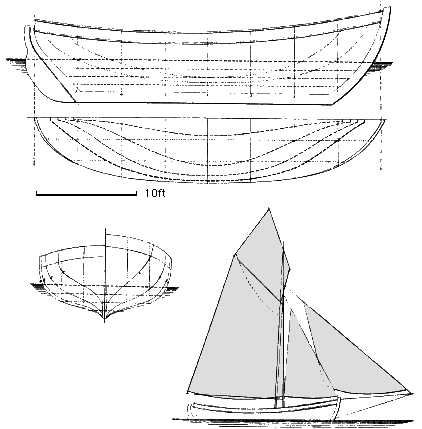
PLAICE-FISHING HORNBAEK BOAT
6 ft. by 13 ft. 8 in. by 5 ft.
For the even more exposed and
boisterous waters of the Kattegat, and the western coast
of the bleak promontory of Jutland, larger tonnage and
greater draught is the rule, while for the eel and other
shallow- water fisheries flat bottom centre-board open
boats are coming in.
The fishing-boats of Hornbaek, at the
northern end of the Island of Siaelland, and of
Skovshoved, on the east coast of Siaelland in the Sound
and north of Copenhagen, will be probably best known to
yachtsmen and seamen, the majority of whom, in vessels of
any draught, pass through the Sound in going and
coming.
OFF ISE FJORD
The Hornbaek boats are very
characteristic in build, and follow the usual rule of
being stem and stern alike and clinker-built. They have
considerable sheer, and remarkable flare on the bows and
quarters. The sternpost is very raked, and the top is
rounded up and cut off, in a manner peculiarly Norse,
below the top of the rail, the tiller passing through an
open cut in the bulwark, and beneath the rail, which is
carried right round. They are cutter rigged, having gaff
and boom mainsail and yard topsail set on the pole-mast.
They are decked in, and are fast and beautiful sea boats.
They are used for plaice and other fishing in the
Kattegat. *1*
Almost identical with these boats, in
build as in rig, are the sole and herring boats of Lynaes
and Hundested, at the mouth of the beautiful Ise Fjord.
They have less sheer, less draught, a trifle more beam in
proportion to their length, and a lower rail than the
Hornbaek boats, but like them they have to face plenty of
bad weather in their fishing-grounds around Anholt and in
the southern part of the Kattegat.
KATTEGAT PLAICE-FISHING BOAT
*1* Approximate dimensions: Length, 36 ft.; beam, 13
ft. 8 in.;
draught, 5 ft.
In most cases the dimensions of the
Danish boats are taken from Captain C. F. Drechsel's
admirable work on the Danish fisheries. Owing to their
shallowness and enormous beam, and their peculiar
dish-like section, these boats, when under way, really
appear to be all deck, and to have scarcely any side at
all. They are wonderfully buoyant dry craft, and their
motion in a sea-way is quite peculiar and strange by one
accustomed to deeper, narrower builds. *1*
FISHING SLOOP, ISE FJORD
A number of these boats
weathering a nor'-wester form a sight which no one who
has been privileged to see it can forget.
*1* Length, 32 ft. 6 in.; beam, 13 ft 8 in. ; draught,
4 ft. 6 in.
Another craft, almost similar in every
particular to the types just mentioned, except that she
is larger and is dandy-rigged, may be here referred to as
hailing from Frederikshavn, at the north-eastern
extremity of the storm-swept Jutland. This boat is also
used in the plaice fishery in the Kattegat, and is, as is
very necessary, a powerful sea-keeping type, of very
strong construction. The mizen, behind which is the
steering well, is often a flat-headed spritsail, and the
mainmast is fitted with a topmast. Such a boat would form
an ideal rough-weather cruiser. *1*
Plaice, sole, and turbot form an
important fishery, and besides the trawl, and shore and
deep-water bottom seine nets, spiller lines and tramel
nets are used all round the coasts. These fish mostly
frequent Anholt and the Aalborg banks, Ise Fjord and the
head of the Sound, and some spots on the west
coast.
The Skovshoved herring-boats, in which
may be included all boats engaged in this important
fishery, sailing from the small harbours of the Sound, as
far south as Faxe Bight at the south-eastern end of
Siaelland, are much smaller in size and are only half
decked. The curve of the stem-piece is very marked and
gives a very rounded forefoot. The stern-post is as usual
very raked, and above the waterline makes that curious
elbow, or forward curve, which is characteristic of the
majority of the Danish boats, and is more developed in
these boats than in any others. They carry their beam
well aft, especially above the waterline, where there is
great flare. The deck plan is peculiar, the little cuddy
which does for a cabin, and has just room for two men to
lie down for an occasional spell, being placed aft at the
quarters just before the tiny well occupied by the
steersman. The boat is open amidships as far as the
mast-thwart, with wide waterways along the
sides.
*1* Approximate dimensions : Length, 42 ft. ; beam, 15
ft.; draught, 6 ft. 6 in.; tonnage, about
24.
In a boat sketched at Vedbaek these
waterways gradually narrowed forward until they vanished
at each bow where the boat was entirely open -- eloquent
witness of the lifting power in a sea-way of the rounded
forefoot and high-flared bows of these boats.
YEDHAEK BOAT
• • •
RODVIG BOAT
At the pretty little harbour of
Rodvig, however, the boats were mostly decked before the
mast; no doubt owing to the very nasty sea to be met with
here, away from the shelter of the Sound, especially when
a strong south-east wind is blowing on to the shallows of
the Faxe Bight.
These boats are from 24 to 25 feet
long overall (22 to 24 LWL), and 8 to 9 feet beam (the
beam more often than not exceeding one-third of the
overall length), and have from 3 feet to 3 feet 6 inches
draught. The mast is stepped well back, 8 to 9 feet from
the bows, and is a stout spar standing 21 to 24 feet from
the deck. The mainsail is a flat-headed spritsail.
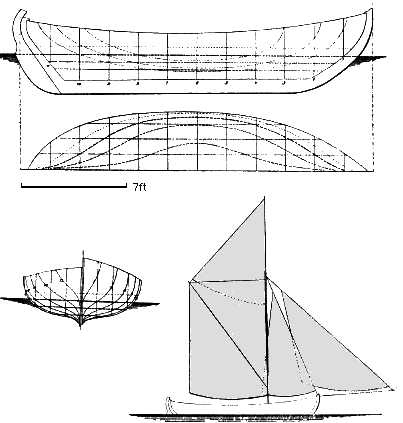
SKOVSHOVED HERRING-BOAT
24 ft. by 8 ft. by 3 ft. 2 in.
The spreet, standing at an angle
of about forty-five degrees with the mast, is about 22
feet long, and its end stands a little below the line of
the masthead. In its cut and proportions the sail is
directly opposed to the principles usually followed in
the fore and aft mainsail, the peak standing lower than
the throat, and the foot being several inches shorter
than the head, so that the leech stands up and down, the
peak standing over the clew. The shape is, at first, by
no means taking to the eye accustomed to well-peaked
sails, although it undoubtedly results in a very
flat-setting sail when close hauled; and it is quickly
and easily reefed, and can be reduced to very snug
proportions in a blow.
OPEN SKIFF
The foresail is a big powerful
sail running on the stout forestay. Like the mainsail it
is generally tanned, and together they form the working
rig of the boat. A light triangular or jib-headed topsail
hoisted on a long spar and a large jib set on a
light-running bowsprit are used in fine weather. It is
noticeable that the Danish fishermen, like the Norwegian
pilots, hold on to the fore staysail when it blows,
although the British smacksman takes it off before any
other lower sail when there is any weight in the wind,
and prefers his small third or storm-jib which, as he
says, presses down a boat much less than the staysail,
and has far more lifting power. The Dane or Norwegian,
however, owing to the great beam of his boat, feels the
pressing influence of a staysail far less, while in his
high-flared overhanging bow he has all the lifting power
he requires. It is curious how, for racing purposes, we
are coming back in this country, as they are in America,
to greater beam and greater overhang and flare
forward.
Both mainsail and foresail have
generally three rows of reef-points in them. The mainsail
is held by a rope lacing to the mast. It is stowed in a
bunch on the mast, and when set is first hoisted well up
by the main halyard and then hauled out to the spreet-end
by the out-haul.
When brailing up the out-haul is let
go and the two brails are hauled upon, the peak and head
of the sail being thus brought down alongside the mast.
The sail is never brailed up at the throat while standing
on the spreet, as is always done in the Thames barge and
other sprit-rigged boats in England.
A very handsome type of little cutter
comes from the neighbourhood of Nystead in the Isle of
Laaland, less peculiarly Danish in type, and having a
transom stern and much straighter stem-post. She is
flatter floored and more straight-sided than those
already described. She has a lofty pole-mast and standing
bowsprit, and is used for the herring net-fishery.
*1*
The herring fishing extends all
through the quiet Belt as well as the Sound. Stake-nets
are extensively used along the shores, especially in the
spring fishing, while the greater part of the autumn
catches are made by drift-nets.
SPRITSAIL HERRING-BOAT
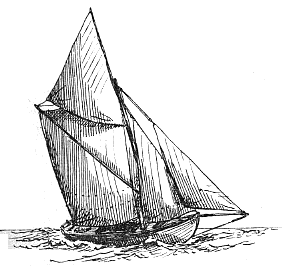 The
solitary island of Bornholm, lying in the Baltic, has
some good boats of its own. The open boats used for the
important herring and spring salmon fisheries are dandy
rigged, the main and mizen sails being spritsails with a
slight peak to them, but still very straight leech. A
yard topsail is sometimes carried, and is set on a kind
of sliding-gunter topmast passing through a cap in the
usual way, the heel of which comes down to within reach
of the deck. The raised stem and stern posts are very
straight. They are mostly 22 feet long and 8 feet beam,
and about 3 feet 8 inches internal depth. The
solitary island of Bornholm, lying in the Baltic, has
some good boats of its own. The open boats used for the
important herring and spring salmon fisheries are dandy
rigged, the main and mizen sails being spritsails with a
slight peak to them, but still very straight leech. A
yard topsail is sometimes carried, and is set on a kind
of sliding-gunter topmast passing through a cap in the
usual way, the heel of which comes down to within reach
of the deck. The raised stem and stern posts are very
straight. They are mostly 22 feet long and 8 feet beam,
and about 3 feet 8 inches internal depth.
*1* Length, 26 ft; beam, 9 ft; draught, 3 ft 6
in.
The larger decked boats used in the
salmon fishery are of the sharp-bottomed wide-flared
build, very like the smaller Skorshoved boat. Forward the
stem-head is carried up some three feet in height,
reminding one much of the Gulf of Bothnia boat. From here
an open rail runs right away aft to the quarter. A small
deck-house aft gives a peculiar appearance to the boat.
She is a pole-masted cutter, the mainsail having no boom,
and being sheeted to a horse inside the stern The
perpendicular line of the leech and the very square head
of the gaff topsail are not at first
prepossessing.
The salmon frequent several of the
shallow fjords of the islands, and are caught in large
numbers off Bornholm on the west, south, and
south-eastern sides. The drift-net is largely used, and
floating hook-lines are set in deeper water
outside.
In the shallow fjords among the
islands, in the Little Belt, or up the flats of the
Aalborg banks on the eastern coast of Jutland,
flat-bottomed open skiffs, as usual stem and stern alike,
are used for eel and plaice and other shallow-water
fisheries. They are fitted with leeboards or
centre-boards, and rigged in one or other of the usual
fashions.
All these shallow waters of the
coastline bear witness to the ingenuity of the local
fisherman in the multitudes of stake-nets and basket-work
traps with which unwary herrings, eels, and flat-fish,
and even more sagacious deep-water fish such as cod, are
beguiled. Not even the much-staked waters of the tropics
can compete with the Baltic in the multiplicity and
variety of these contrivances.
*1* These boats run to about 33 ft. long, 11 ft. 6 in.
beam, 4 ft. 6 in. draught aft, and 4 ft
forward.
While the principal scenes of the
herring fishery are in the Kattegat and through the Great
Belt and the Sound to the shores of Bornholm, the cod and
haddock frequent mostly the west, or North Sea, coast of
Jutland, and the boats used in this fishery are large,
powerful craft. Some of the regular North Sea dandy
rigged smacks are now used in this fishery with counters
and straight stems, but the visitor to the little port of
Esbjerg will find plenty that is novel and interesting in
some of the stout cod-line boats lying there, or in the
beamy little traders from the south. A typical Danish
type of boat used here is about 87 feet in length, 13
feet 9 inches in beam, and over 6 feet in draught. She
has a curious turn up to the stem-head, not unlike the
snub-nose of some of our modern racers. She is, as usual,
stem and stern alike, but has full rounded ends and
sharper bottom than is usual. She is cutter-rigged with
gaff and boom mainsail, standing bowsprit and topmast of
very English proportions.
The open boats are spritsail rigged,
with an also much more familiar shape of sail. They have
straight overhanging stem and stern posts, and a great
deal of flare and sheer, and are very round at the
gunwale at each end. They run up to 26 feet by
8.
In this fishery, which is carried on
in many spots round the eastern Jutland coast, and among
the islands, as well as out deep in the North Sea, the
hook and line is much used, while stake-nets and traps
are used in the Belts, and in the more sheltered shallow
waters of the main islands.
Sweden
Perhaps the most characteristic
feature of the Swedish boat-builder is his love of beam
and solidity.
SWEDISH FISHING-BOAT
No stronger, finer sea-boats are
to be found in the world than some of these Swedish
fishing craft.
The open boats used in the cod and
herring net fisheries are, in their way, perhaps the most
remarkable craft afloat. Their characteristics are
monstrous beam and great strength. For a length of 17
feet some of them have a beam of 13, and yet, owing to
the beautiful curves, there is no sense of awkwardness
about them. They are clinker-built, with sharp floors and
raking stern-post, and carry one large spritsail. The
head of the sprit, instead of being pointed for fitting
in the grommet at the mast, is generally forked.
*1*
|
*1* Dimensions:
|
|
Length
|
Beam
|
Depth
|
|
25 feet 8 inches
|
9 feet 10 inches
|
3 feet 3 inches.
|
|
17 feet 0 inches
|
13 feet 0 inches
|
4 feet 0 inches
|
The big-decked Swedish mackerel boat
is not less remarkable. That she is clinker-built, stem
and stern alike, and has a very raking stern-post, and
great beam, goes without saying. She has hollow floor,
and a deep heel, and is about the strongest and most
powerful sea boat of her size in the world. There is a
double rail all round. She is dandy-rigged, with the
sprit, mizen, and main sails familiar in the Danish and
Norwegian boats, and a very long topsail-yard running up
and down the mast, sliding gunter fashion. The mast being
very stout there is, as usual, very little rigging, there
being a single stay on each side, and no
runners.
There is a threefold sheave at the
masthead to accommodate the mainsail, spreet, and fore
staysail halyards. The mainsail is set by hauling out on
the standing spreet, as already described in the
Skovsboved boats, and is brailed down in the usual
Scandinavian manner to the mast. It can be reefed down
very small.
The sheet travels on a horse. The
mizen has no standing rigging, and has a double sheave at
the masthead, through which are rove the mizen-sail and
mizen topsail halyards. The sheet leads to a wooden boom
over the stern. *1*
Of the very remarkable square-rigged
cargo-carriers of the inland waterways about Gotenburg I
have unfortunately no experience. That they are able hold
a very close wind is apparent even to the railway
traveller, and they will probably amply repay the
investigation which I hope one day to give
them.
|
*1* Small boats of this type are also built.
Dimensions:
|
|
Length
|
Beam
|
Depth
|
|
36 feet
|
17 feet 0 inches
|
7 feet 5 inches.
|
|
28 feet
|
9 feet 10 inches
|
3 to 4 feet.
|
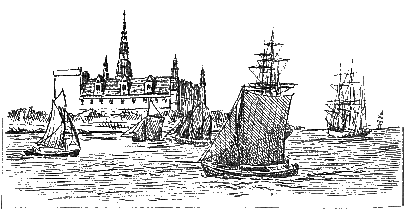
UNDER THE LEE OF KRONBURG
|

 Not
less than the men, the craft of the Baltic form a
never-ending source of interest, and have very well
marked characteristics. With scarcely an exception the
sharp stern is used in all the fishing craft, whether
Finnish, Swedish, Danish, or Norwegian. Sharp floors,
great beam, and considerable rake of stem and stern post,
with wide flare forward, are the rule. The boats are
nearly always clinker-built in wide strakes of great
thickness, and when undecked they usually have high
sheer. The materials used are oak or fir, and wooden
pegging is much resorted to.
Not
less than the men, the craft of the Baltic form a
never-ending source of interest, and have very well
marked characteristics. With scarcely an exception the
sharp stern is used in all the fishing craft, whether
Finnish, Swedish, Danish, or Norwegian. Sharp floors,
great beam, and considerable rake of stem and stern post,
with wide flare forward, are the rule. The boats are
nearly always clinker-built in wide strakes of great
thickness, and when undecked they usually have high
sheer. The materials used are oak or fir, and wooden
pegging is much resorted to.
 The
solitary island of Bornholm, lying in the Baltic, has
some good boats of its own. The open boats used for the
important herring and spring salmon fisheries are dandy
rigged, the main and mizen sails being spritsails with a
slight peak to them, but still very straight leech. A
yard topsail is sometimes carried, and is set on a kind
of sliding-gunter topmast passing through a cap in the
usual way, the heel of which comes down to within reach
of the deck. The raised stem and stern posts are very
straight. They are mostly 22 feet long and 8 feet beam,
and about 3 feet 8 inches internal depth.
The
solitary island of Bornholm, lying in the Baltic, has
some good boats of its own. The open boats used for the
important herring and spring salmon fisheries are dandy
rigged, the main and mizen sails being spritsails with a
slight peak to them, but still very straight leech. A
yard topsail is sometimes carried, and is set on a kind
of sliding-gunter topmast passing through a cap in the
usual way, the heel of which comes down to within reach
of the deck. The raised stem and stern posts are very
straight. They are mostly 22 feet long and 8 feet beam,
and about 3 feet 8 inches internal depth.